Understanding Stress Urinary Incontinence
VerifiedAdded on 2020/05/16
|11
|3069
|47
AI Summary
This assignment delves into the complexities of stress urinary incontinence (SUI) in women. It requires students to analyze numerous research articles provided, encompassing topics like prevalence, diagnosis, treatment options, psychosocial effects, and the influence of factors like obesity. The analysis aims to provide a comprehensive understanding of SUI and its implications for women's health.
Contribute Materials
Your contribution can guide someone’s learning journey. Share your
documents today.
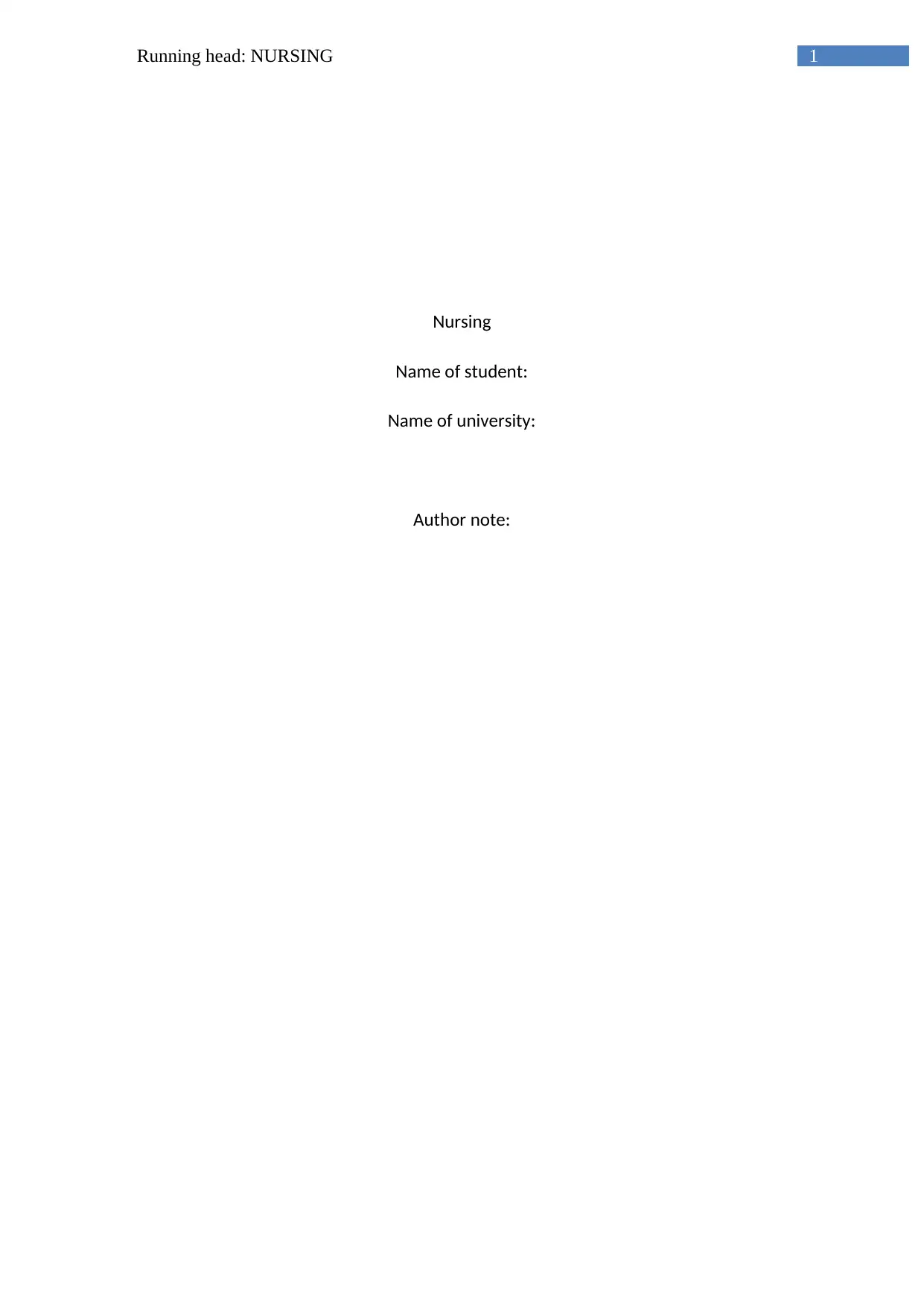
1Running head: NURSING
Nursing
Name of student:
Name of university:
Author note:
Nursing
Name of student:
Name of university:
Author note:
Secure Best Marks with AI Grader
Need help grading? Try our AI Grader for instant feedback on your assignments.

2
NURSING
Female stress urinary incontinence (UI) is a common symptom experienced by
significant numbers of adult women. The concern has drawn the significant attention of the
healthcare sectors worldwide due to the continuously ageing population. The present essay
is an evidence-based discussion on the nursing topic of female stress urinary incontinence
(UI). The essay provides a definition of stress UI and the prevalence of the same in Australia.
Next, it assesses the financial impact of stress UI on a client. Pathophysiology of the disease,
risk factors and complications, and impact of stress UI on psychological wellbeing and
intimate relationships with the client are next discussed. The following part of the essay
focuses on the recommended referrals, including services available in the area of Brimbank
Council. Further, treatment of stress UI would be highlighted with special reference to
Australia. Lastly, the role of community nurses in managing and supporting clients with
stress UI would be outlined.
Wood and Anger (2014) provided the definition for stress UI as a clinical sign, a
urodynamic observation and a symptom involving involuntary leakage of urine on efforts
such as coughing, sneezing and exertion. It is an involuntary loss of urine and is so severe
that it is known to have adverse hygiene and social consequences. Stress UI in females is a
health concern leading to distress and inconvenience in a significant section of the women
population around the globe. Though it is common among women of older age, problems
with urinary bladder are not always a consequence of age and limited to the elderly
population.
Stress UI has effected millions of women across the globe that leads to poor quality
of life in those who suffer from it. Urinary incontinence is becoming a high burden of
suffering in Australia, and statistics had been gathered by healthcare departments to
NURSING
Female stress urinary incontinence (UI) is a common symptom experienced by
significant numbers of adult women. The concern has drawn the significant attention of the
healthcare sectors worldwide due to the continuously ageing population. The present essay
is an evidence-based discussion on the nursing topic of female stress urinary incontinence
(UI). The essay provides a definition of stress UI and the prevalence of the same in Australia.
Next, it assesses the financial impact of stress UI on a client. Pathophysiology of the disease,
risk factors and complications, and impact of stress UI on psychological wellbeing and
intimate relationships with the client are next discussed. The following part of the essay
focuses on the recommended referrals, including services available in the area of Brimbank
Council. Further, treatment of stress UI would be highlighted with special reference to
Australia. Lastly, the role of community nurses in managing and supporting clients with
stress UI would be outlined.
Wood and Anger (2014) provided the definition for stress UI as a clinical sign, a
urodynamic observation and a symptom involving involuntary leakage of urine on efforts
such as coughing, sneezing and exertion. It is an involuntary loss of urine and is so severe
that it is known to have adverse hygiene and social consequences. Stress UI in females is a
health concern leading to distress and inconvenience in a significant section of the women
population around the globe. Though it is common among women of older age, problems
with urinary bladder are not always a consequence of age and limited to the elderly
population.
Stress UI has effected millions of women across the globe that leads to poor quality
of life in those who suffer from it. Urinary incontinence is becoming a high burden of
suffering in Australia, and statistics had been gathered by healthcare departments to
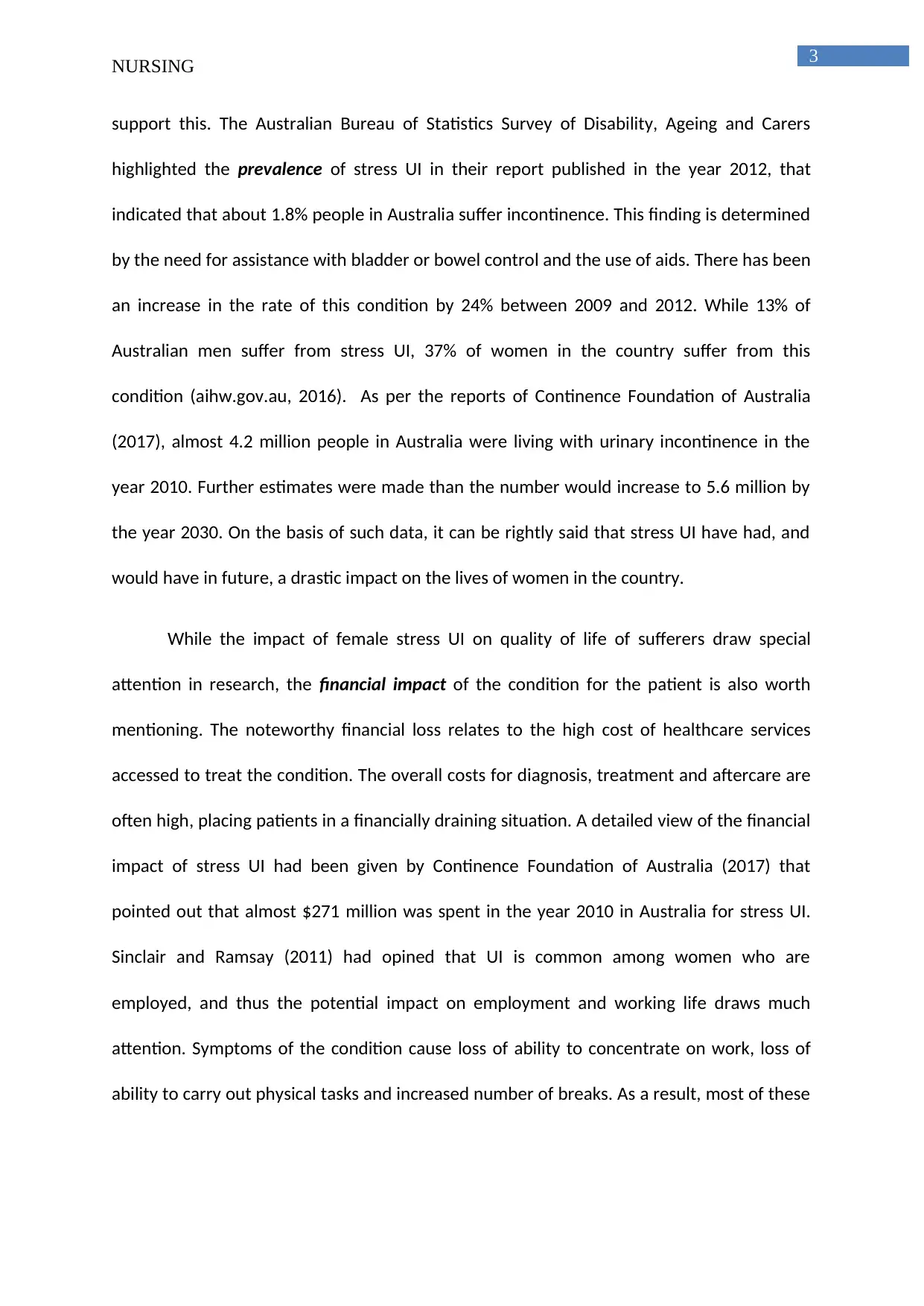
3
NURSING
support this. The Australian Bureau of Statistics Survey of Disability, Ageing and Carers
highlighted the prevalence of stress UI in their report published in the year 2012, that
indicated that about 1.8% people in Australia suffer incontinence. This finding is determined
by the need for assistance with bladder or bowel control and the use of aids. There has been
an increase in the rate of this condition by 24% between 2009 and 2012. While 13% of
Australian men suffer from stress UI, 37% of women in the country suffer from this
condition (aihw.gov.au, 2016). As per the reports of Continence Foundation of Australia
(2017), almost 4.2 million people in Australia were living with urinary incontinence in the
year 2010. Further estimates were made than the number would increase to 5.6 million by
the year 2030. On the basis of such data, it can be rightly said that stress UI have had, and
would have in future, a drastic impact on the lives of women in the country.
While the impact of female stress UI on quality of life of sufferers draw special
attention in research, the financial impact of the condition for the patient is also worth
mentioning. The noteworthy financial loss relates to the high cost of healthcare services
accessed to treat the condition. The overall costs for diagnosis, treatment and aftercare are
often high, placing patients in a financially draining situation. A detailed view of the financial
impact of stress UI had been given by Continence Foundation of Australia (2017) that
pointed out that almost $271 million was spent in the year 2010 in Australia for stress UI.
Sinclair and Ramsay (2011) had opined that UI is common among women who are
employed, and thus the potential impact on employment and working life draws much
attention. Symptoms of the condition cause loss of ability to concentrate on work, loss of
ability to carry out physical tasks and increased number of breaks. As a result, most of these
NURSING
support this. The Australian Bureau of Statistics Survey of Disability, Ageing and Carers
highlighted the prevalence of stress UI in their report published in the year 2012, that
indicated that about 1.8% people in Australia suffer incontinence. This finding is determined
by the need for assistance with bladder or bowel control and the use of aids. There has been
an increase in the rate of this condition by 24% between 2009 and 2012. While 13% of
Australian men suffer from stress UI, 37% of women in the country suffer from this
condition (aihw.gov.au, 2016). As per the reports of Continence Foundation of Australia
(2017), almost 4.2 million people in Australia were living with urinary incontinence in the
year 2010. Further estimates were made than the number would increase to 5.6 million by
the year 2030. On the basis of such data, it can be rightly said that stress UI have had, and
would have in future, a drastic impact on the lives of women in the country.
While the impact of female stress UI on quality of life of sufferers draw special
attention in research, the financial impact of the condition for the patient is also worth
mentioning. The noteworthy financial loss relates to the high cost of healthcare services
accessed to treat the condition. The overall costs for diagnosis, treatment and aftercare are
often high, placing patients in a financially draining situation. A detailed view of the financial
impact of stress UI had been given by Continence Foundation of Australia (2017) that
pointed out that almost $271 million was spent in the year 2010 in Australia for stress UI.
Sinclair and Ramsay (2011) had opined that UI is common among women who are
employed, and thus the potential impact on employment and working life draws much
attention. Symptoms of the condition cause loss of ability to concentrate on work, loss of
ability to carry out physical tasks and increased number of breaks. As a result, most of these

4
NURSING
women remain absent from work for a considerable amount of time and are bound to suffer
financial loss.
The pathophysiology of stress UI can be well understood by reading the research
paper of Arshiya et al., (2015). The continence pathophysiology has the underlying
mechanism involving a series of muscles, nerves, and connective tissue that play a role in
dynamically influencing bladder control. The organised arrangement allows complete and
timely bladder emptying, and the individual is able to maintain continence when there is
abdominal pressure. Continence depends on the lower urinary tract which has to be
functionally and structurally normal. Stress UI is the condition occurring when there is
considerable damage suffered in the nerves, connective tissue and nerves of the pelvic floor.
The main determinants of continence are a function of the urethral muscle, vesical neck
function, and urethral support. The action of the levator ani muscles supports the urethra
through the connection built with the endopelvic fascia of the anterior vaginal wall. When
there is damage suffered in this connection between the muscle and fascia, nerve supply to
the muscle is lost. There are also high chances of suffering direct muscle damage. This
condition results in incontinence. Further, impairment of vesical neck closure leads to
incontinence even when the urethral support is normal. It is to be remembered that the
main causes of damage suffered are linked to hyperglycemia, obesity, chronic bacterial
colonization and urinary tract infections.
Bagnola et al., (2017) outlined the risk factors for stress UI in their research paper
that linked childbirth menopause and pregnancy with UI as the major risk factors. Some of
the other risk factors for UI can be attributed to problems of constipation, underlying
musculoskeletal or neurological conditions and impaired mobility. The common underlying
NURSING
women remain absent from work for a considerable amount of time and are bound to suffer
financial loss.
The pathophysiology of stress UI can be well understood by reading the research
paper of Arshiya et al., (2015). The continence pathophysiology has the underlying
mechanism involving a series of muscles, nerves, and connective tissue that play a role in
dynamically influencing bladder control. The organised arrangement allows complete and
timely bladder emptying, and the individual is able to maintain continence when there is
abdominal pressure. Continence depends on the lower urinary tract which has to be
functionally and structurally normal. Stress UI is the condition occurring when there is
considerable damage suffered in the nerves, connective tissue and nerves of the pelvic floor.
The main determinants of continence are a function of the urethral muscle, vesical neck
function, and urethral support. The action of the levator ani muscles supports the urethra
through the connection built with the endopelvic fascia of the anterior vaginal wall. When
there is damage suffered in this connection between the muscle and fascia, nerve supply to
the muscle is lost. There are also high chances of suffering direct muscle damage. This
condition results in incontinence. Further, impairment of vesical neck closure leads to
incontinence even when the urethral support is normal. It is to be remembered that the
main causes of damage suffered are linked to hyperglycemia, obesity, chronic bacterial
colonization and urinary tract infections.
Bagnola et al., (2017) outlined the risk factors for stress UI in their research paper
that linked childbirth menopause and pregnancy with UI as the major risk factors. Some of
the other risk factors for UI can be attributed to problems of constipation, underlying
musculoskeletal or neurological conditions and impaired mobility. The common underlying
Secure Best Marks with AI Grader
Need help grading? Try our AI Grader for instant feedback on your assignments.
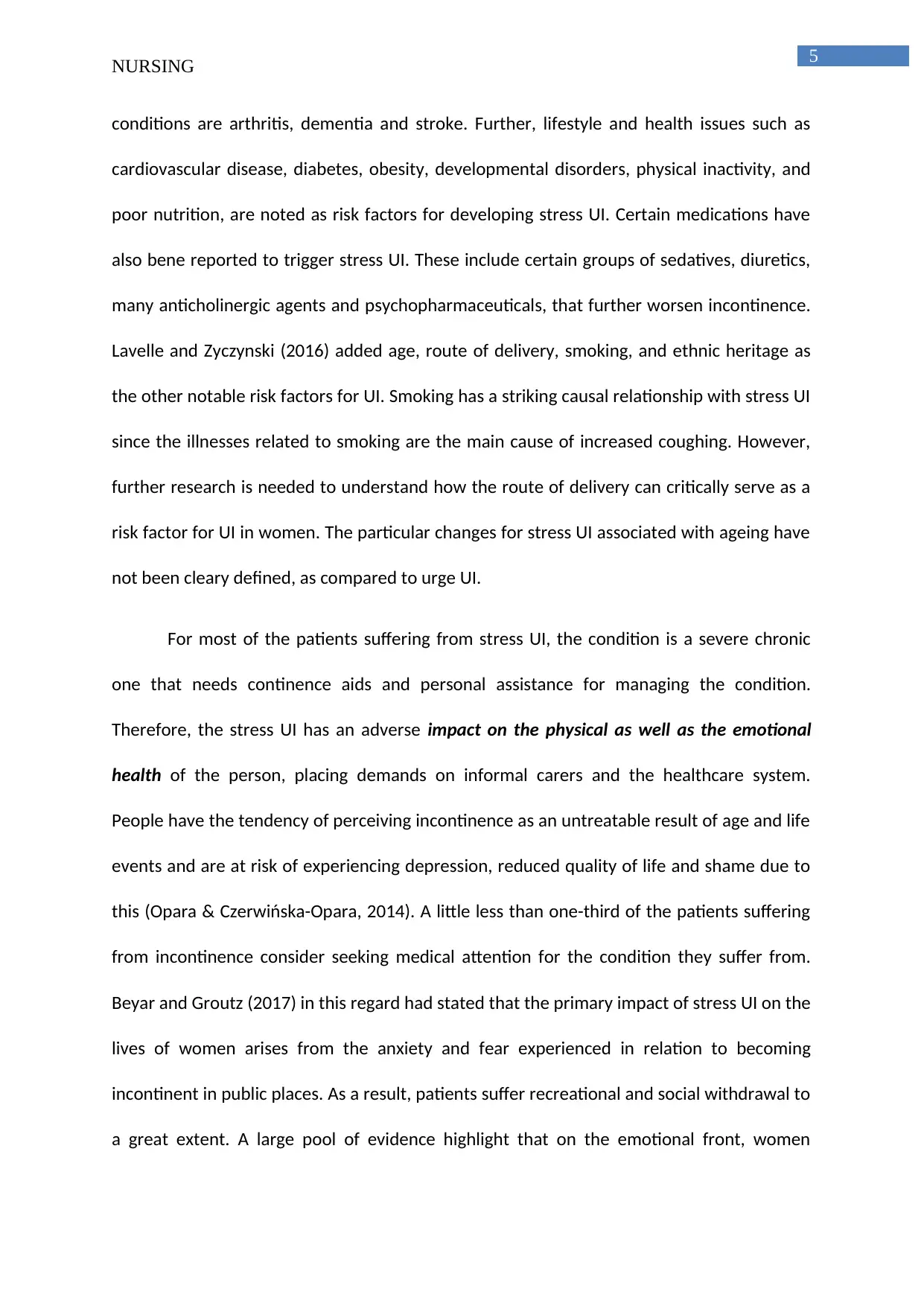
5
NURSING
conditions are arthritis, dementia and stroke. Further, lifestyle and health issues such as
cardiovascular disease, diabetes, obesity, developmental disorders, physical inactivity, and
poor nutrition, are noted as risk factors for developing stress UI. Certain medications have
also bene reported to trigger stress UI. These include certain groups of sedatives, diuretics,
many anticholinergic agents and psychopharmaceuticals, that further worsen incontinence.
Lavelle and Zyczynski (2016) added age, route of delivery, smoking, and ethnic heritage as
the other notable risk factors for UI. Smoking has a striking causal relationship with stress UI
since the illnesses related to smoking are the main cause of increased coughing. However,
further research is needed to understand how the route of delivery can critically serve as a
risk factor for UI in women. The particular changes for stress UI associated with ageing have
not been cleary defined, as compared to urge UI.
For most of the patients suffering from stress UI, the condition is a severe chronic
one that needs continence aids and personal assistance for managing the condition.
Therefore, the stress UI has an adverse impact on the physical as well as the emotional
health of the person, placing demands on informal carers and the healthcare system.
People have the tendency of perceiving incontinence as an untreatable result of age and life
events and are at risk of experiencing depression, reduced quality of life and shame due to
this (Opara & Czerwińska-Opara, 2014). A little less than one-third of the patients suffering
from incontinence consider seeking medical attention for the condition they suffer from.
Beyar and Groutz (2017) in this regard had stated that the primary impact of stress UI on the
lives of women arises from the anxiety and fear experienced in relation to becoming
incontinent in public places. As a result, patients suffer recreational and social withdrawal to
a great extent. A large pool of evidence highlight that on the emotional front, women
NURSING
conditions are arthritis, dementia and stroke. Further, lifestyle and health issues such as
cardiovascular disease, diabetes, obesity, developmental disorders, physical inactivity, and
poor nutrition, are noted as risk factors for developing stress UI. Certain medications have
also bene reported to trigger stress UI. These include certain groups of sedatives, diuretics,
many anticholinergic agents and psychopharmaceuticals, that further worsen incontinence.
Lavelle and Zyczynski (2016) added age, route of delivery, smoking, and ethnic heritage as
the other notable risk factors for UI. Smoking has a striking causal relationship with stress UI
since the illnesses related to smoking are the main cause of increased coughing. However,
further research is needed to understand how the route of delivery can critically serve as a
risk factor for UI in women. The particular changes for stress UI associated with ageing have
not been cleary defined, as compared to urge UI.
For most of the patients suffering from stress UI, the condition is a severe chronic
one that needs continence aids and personal assistance for managing the condition.
Therefore, the stress UI has an adverse impact on the physical as well as the emotional
health of the person, placing demands on informal carers and the healthcare system.
People have the tendency of perceiving incontinence as an untreatable result of age and life
events and are at risk of experiencing depression, reduced quality of life and shame due to
this (Opara & Czerwińska-Opara, 2014). A little less than one-third of the patients suffering
from incontinence consider seeking medical attention for the condition they suffer from.
Beyar and Groutz (2017) in this regard had stated that the primary impact of stress UI on the
lives of women arises from the anxiety and fear experienced in relation to becoming
incontinent in public places. As a result, patients suffer recreational and social withdrawal to
a great extent. A large pool of evidence highlight that on the emotional front, women
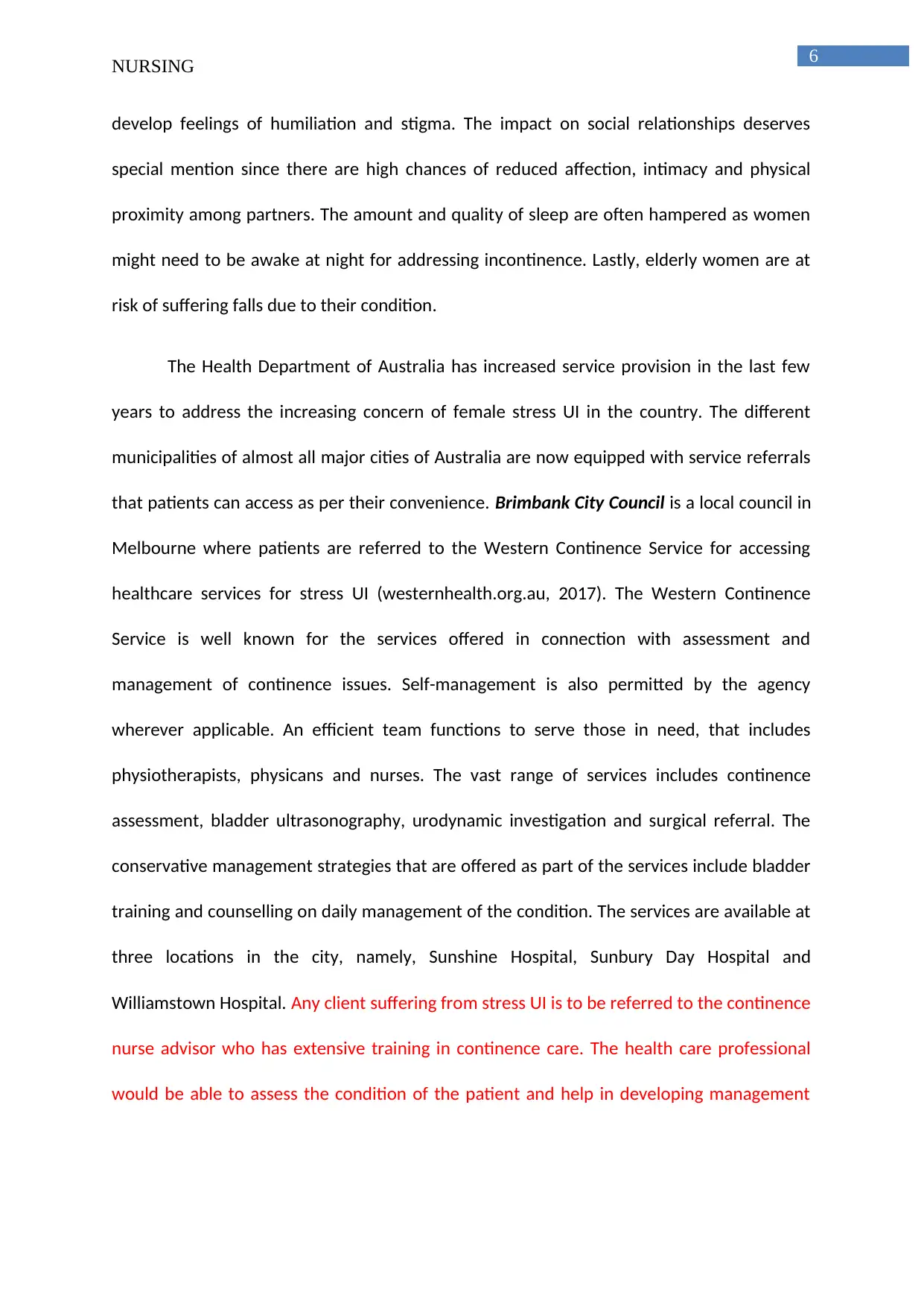
6
NURSING
develop feelings of humiliation and stigma. The impact on social relationships deserves
special mention since there are high chances of reduced affection, intimacy and physical
proximity among partners. The amount and quality of sleep are often hampered as women
might need to be awake at night for addressing incontinence. Lastly, elderly women are at
risk of suffering falls due to their condition.
The Health Department of Australia has increased service provision in the last few
years to address the increasing concern of female stress UI in the country. The different
municipalities of almost all major cities of Australia are now equipped with service referrals
that patients can access as per their convenience. Brimbank City Council is a local council in
Melbourne where patients are referred to the Western Continence Service for accessing
healthcare services for stress UI (westernhealth.org.au, 2017). The Western Continence
Service is well known for the services offered in connection with assessment and
management of continence issues. Self-management is also permitted by the agency
wherever applicable. An efficient team functions to serve those in need, that includes
physiotherapists, physicans and nurses. The vast range of services includes continence
assessment, bladder ultrasonography, urodynamic investigation and surgical referral. The
conservative management strategies that are offered as part of the services include bladder
training and counselling on daily management of the condition. The services are available at
three locations in the city, namely, Sunshine Hospital, Sunbury Day Hospital and
Williamstown Hospital. Any client suffering from stress UI is to be referred to the continence
nurse advisor who has extensive training in continence care. The health care professional
would be able to assess the condition of the patient and help in developing management
NURSING
develop feelings of humiliation and stigma. The impact on social relationships deserves
special mention since there are high chances of reduced affection, intimacy and physical
proximity among partners. The amount and quality of sleep are often hampered as women
might need to be awake at night for addressing incontinence. Lastly, elderly women are at
risk of suffering falls due to their condition.
The Health Department of Australia has increased service provision in the last few
years to address the increasing concern of female stress UI in the country. The different
municipalities of almost all major cities of Australia are now equipped with service referrals
that patients can access as per their convenience. Brimbank City Council is a local council in
Melbourne where patients are referred to the Western Continence Service for accessing
healthcare services for stress UI (westernhealth.org.au, 2017). The Western Continence
Service is well known for the services offered in connection with assessment and
management of continence issues. Self-management is also permitted by the agency
wherever applicable. An efficient team functions to serve those in need, that includes
physiotherapists, physicans and nurses. The vast range of services includes continence
assessment, bladder ultrasonography, urodynamic investigation and surgical referral. The
conservative management strategies that are offered as part of the services include bladder
training and counselling on daily management of the condition. The services are available at
three locations in the city, namely, Sunshine Hospital, Sunbury Day Hospital and
Williamstown Hospital. Any client suffering from stress UI is to be referred to the continence
nurse advisor who has extensive training in continence care. The health care professional
would be able to assess the condition of the patient and help in developing management
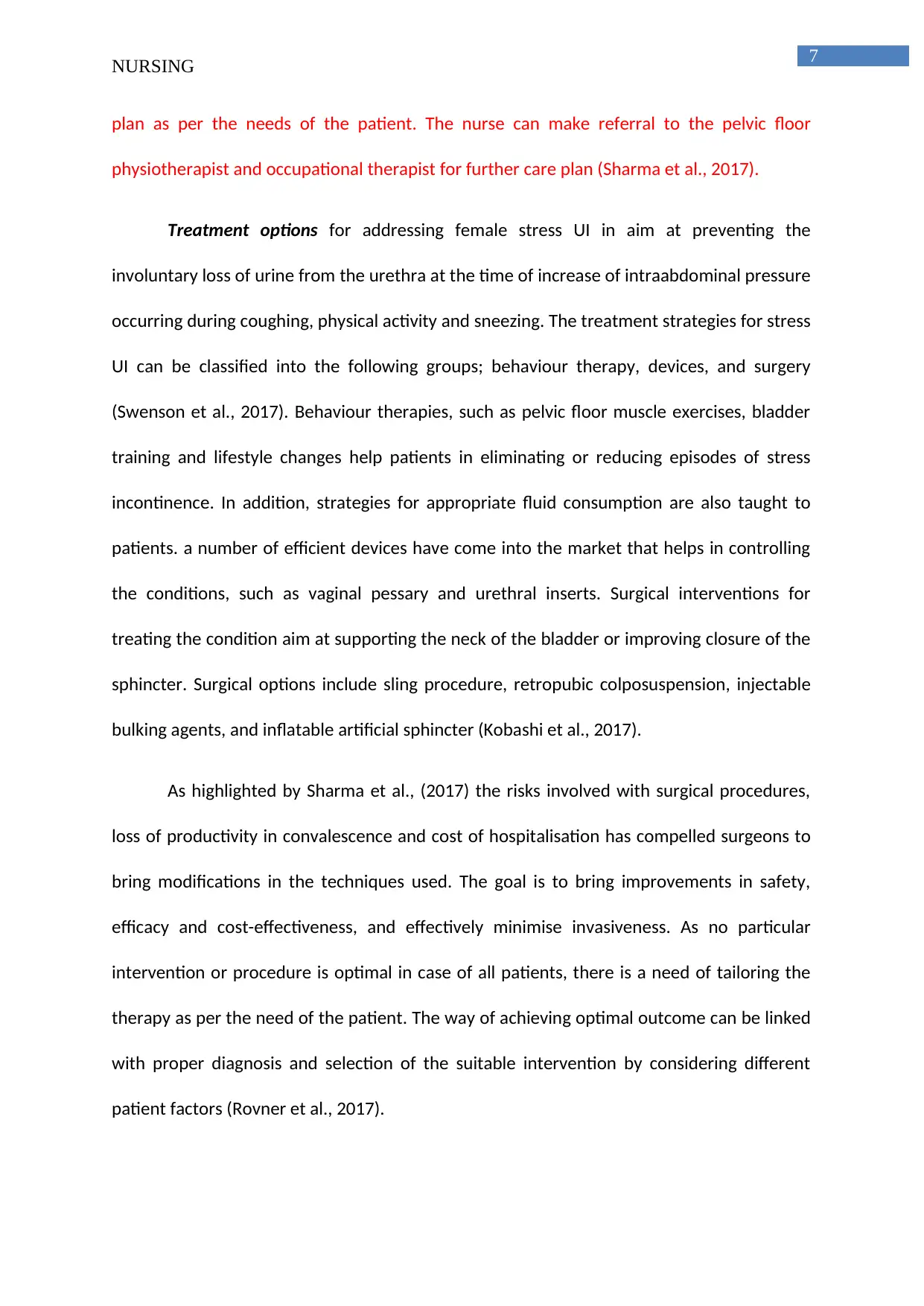
7
NURSING
plan as per the needs of the patient. The nurse can make referral to the pelvic floor
physiotherapist and occupational therapist for further care plan (Sharma et al., 2017).
Treatment options for addressing female stress UI in aim at preventing the
involuntary loss of urine from the urethra at the time of increase of intraabdominal pressure
occurring during coughing, physical activity and sneezing. The treatment strategies for stress
UI can be classified into the following groups; behaviour therapy, devices, and surgery
(Swenson et al., 2017). Behaviour therapies, such as pelvic floor muscle exercises, bladder
training and lifestyle changes help patients in eliminating or reducing episodes of stress
incontinence. In addition, strategies for appropriate fluid consumption are also taught to
patients. a number of efficient devices have come into the market that helps in controlling
the conditions, such as vaginal pessary and urethral inserts. Surgical interventions for
treating the condition aim at supporting the neck of the bladder or improving closure of the
sphincter. Surgical options include sling procedure, retropubic colposuspension, injectable
bulking agents, and inflatable artificial sphincter (Kobashi et al., 2017).
As highlighted by Sharma et al., (2017) the risks involved with surgical procedures,
loss of productivity in convalescence and cost of hospitalisation has compelled surgeons to
bring modifications in the techniques used. The goal is to bring improvements in safety,
efficacy and cost-effectiveness, and effectively minimise invasiveness. As no particular
intervention or procedure is optimal in case of all patients, there is a need of tailoring the
therapy as per the need of the patient. The way of achieving optimal outcome can be linked
with proper diagnosis and selection of the suitable intervention by considering different
patient factors (Rovner et al., 2017).
NURSING
plan as per the needs of the patient. The nurse can make referral to the pelvic floor
physiotherapist and occupational therapist for further care plan (Sharma et al., 2017).
Treatment options for addressing female stress UI in aim at preventing the
involuntary loss of urine from the urethra at the time of increase of intraabdominal pressure
occurring during coughing, physical activity and sneezing. The treatment strategies for stress
UI can be classified into the following groups; behaviour therapy, devices, and surgery
(Swenson et al., 2017). Behaviour therapies, such as pelvic floor muscle exercises, bladder
training and lifestyle changes help patients in eliminating or reducing episodes of stress
incontinence. In addition, strategies for appropriate fluid consumption are also taught to
patients. a number of efficient devices have come into the market that helps in controlling
the conditions, such as vaginal pessary and urethral inserts. Surgical interventions for
treating the condition aim at supporting the neck of the bladder or improving closure of the
sphincter. Surgical options include sling procedure, retropubic colposuspension, injectable
bulking agents, and inflatable artificial sphincter (Kobashi et al., 2017).
As highlighted by Sharma et al., (2017) the risks involved with surgical procedures,
loss of productivity in convalescence and cost of hospitalisation has compelled surgeons to
bring modifications in the techniques used. The goal is to bring improvements in safety,
efficacy and cost-effectiveness, and effectively minimise invasiveness. As no particular
intervention or procedure is optimal in case of all patients, there is a need of tailoring the
therapy as per the need of the patient. The way of achieving optimal outcome can be linked
with proper diagnosis and selection of the suitable intervention by considering different
patient factors (Rovner et al., 2017).
Paraphrase This Document
Need a fresh take? Get an instant paraphrase of this document with our AI Paraphraser
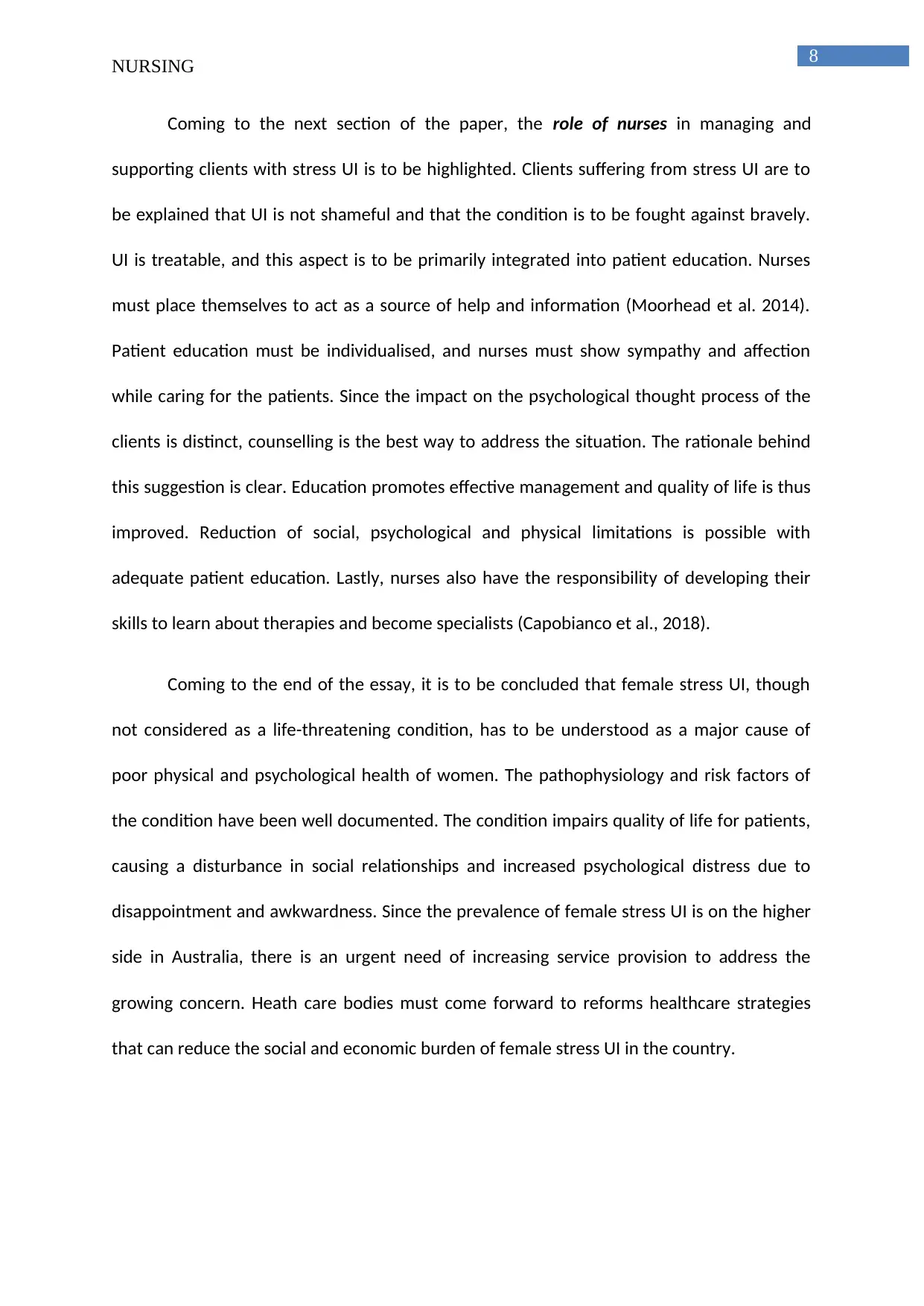
8
NURSING
Coming to the next section of the paper, the role of nurses in managing and
supporting clients with stress UI is to be highlighted. Clients suffering from stress UI are to
be explained that UI is not shameful and that the condition is to be fought against bravely.
UI is treatable, and this aspect is to be primarily integrated into patient education. Nurses
must place themselves to act as a source of help and information (Moorhead et al. 2014).
Patient education must be individualised, and nurses must show sympathy and affection
while caring for the patients. Since the impact on the psychological thought process of the
clients is distinct, counselling is the best way to address the situation. The rationale behind
this suggestion is clear. Education promotes effective management and quality of life is thus
improved. Reduction of social, psychological and physical limitations is possible with
adequate patient education. Lastly, nurses also have the responsibility of developing their
skills to learn about therapies and become specialists (Capobianco et al., 2018).
Coming to the end of the essay, it is to be concluded that female stress UI, though
not considered as a life-threatening condition, has to be understood as a major cause of
poor physical and psychological health of women. The pathophysiology and risk factors of
the condition have been well documented. The condition impairs quality of life for patients,
causing a disturbance in social relationships and increased psychological distress due to
disappointment and awkwardness. Since the prevalence of female stress UI is on the higher
side in Australia, there is an urgent need of increasing service provision to address the
growing concern. Heath care bodies must come forward to reforms healthcare strategies
that can reduce the social and economic burden of female stress UI in the country.
NURSING
Coming to the next section of the paper, the role of nurses in managing and
supporting clients with stress UI is to be highlighted. Clients suffering from stress UI are to
be explained that UI is not shameful and that the condition is to be fought against bravely.
UI is treatable, and this aspect is to be primarily integrated into patient education. Nurses
must place themselves to act as a source of help and information (Moorhead et al. 2014).
Patient education must be individualised, and nurses must show sympathy and affection
while caring for the patients. Since the impact on the psychological thought process of the
clients is distinct, counselling is the best way to address the situation. The rationale behind
this suggestion is clear. Education promotes effective management and quality of life is thus
improved. Reduction of social, psychological and physical limitations is possible with
adequate patient education. Lastly, nurses also have the responsibility of developing their
skills to learn about therapies and become specialists (Capobianco et al., 2018).
Coming to the end of the essay, it is to be concluded that female stress UI, though
not considered as a life-threatening condition, has to be understood as a major cause of
poor physical and psychological health of women. The pathophysiology and risk factors of
the condition have been well documented. The condition impairs quality of life for patients,
causing a disturbance in social relationships and increased psychological distress due to
disappointment and awkwardness. Since the prevalence of female stress UI is on the higher
side in Australia, there is an urgent need of increasing service provision to address the
growing concern. Heath care bodies must come forward to reforms healthcare strategies
that can reduce the social and economic burden of female stress UI in the country.
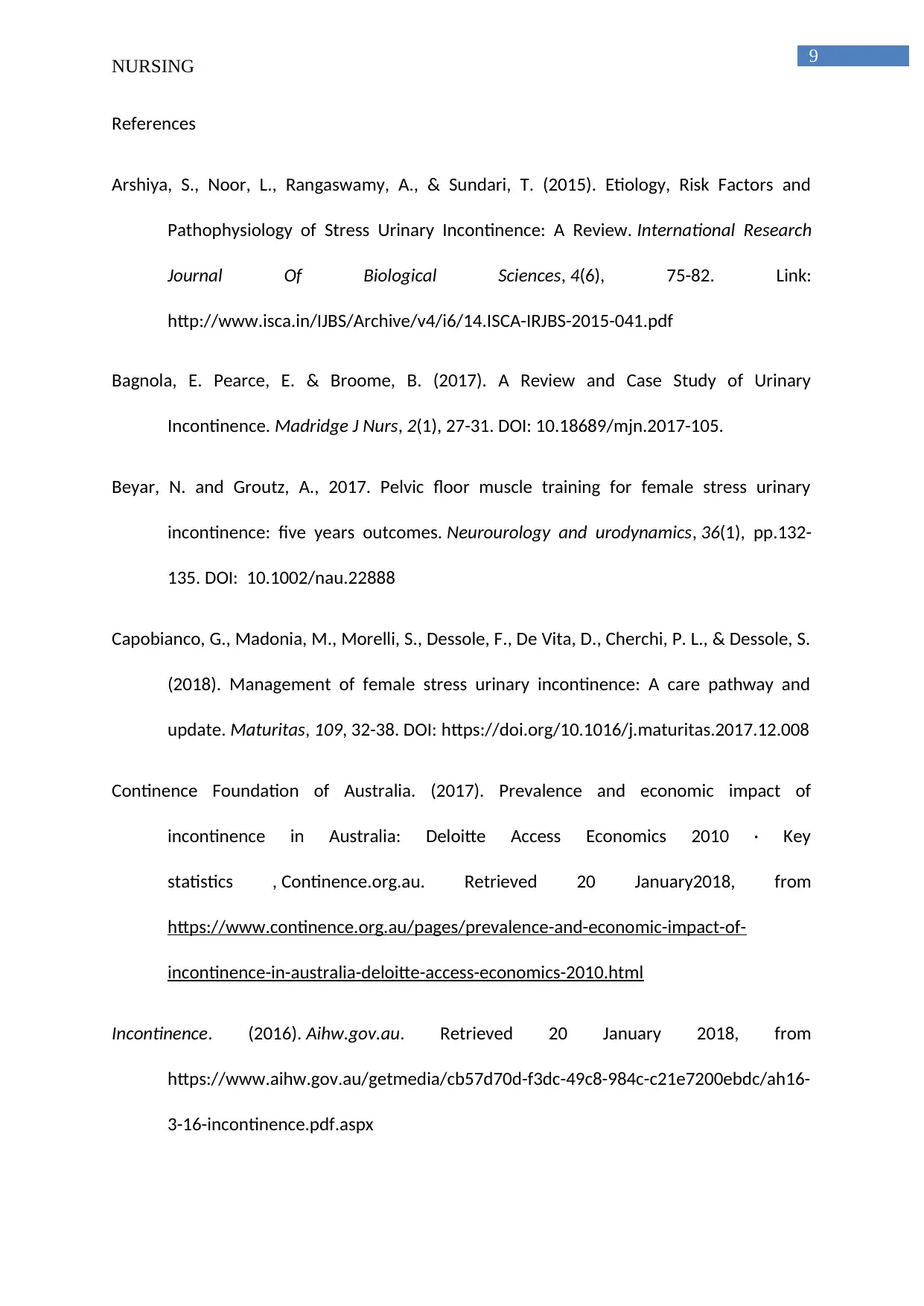
9
NURSING
References
Arshiya, S., Noor, L., Rangaswamy, A., & Sundari, T. (2015). Etiology, Risk Factors and
Pathophysiology of Stress Urinary Incontinence: A Review. International Research
Journal Of Biological Sciences, 4(6), 75-82. Link:
http://www.isca.in/IJBS/Archive/v4/i6/14.ISCA-IRJBS-2015-041.pdf
Bagnola, E. Pearce, E. & Broome, B. (2017). A Review and Case Study of Urinary
Incontinence. Madridge J Nurs, 2(1), 27-31. DOI: 10.18689/mjn.2017-105.
Beyar, N. and Groutz, A., 2017. Pelvic floor muscle training for female stress urinary
incontinence: five years outcomes. Neurourology and urodynamics, 36(1), pp.132-
135. DOI: 10.1002/nau.22888
Capobianco, G., Madonia, M., Morelli, S., Dessole, F., De Vita, D., Cherchi, P. L., & Dessole, S.
(2018). Management of female stress urinary incontinence: A care pathway and
update. Maturitas, 109, 32-38. DOI: https://doi.org/10.1016/j.maturitas.2017.12.008
Continence Foundation of Australia. (2017). Prevalence and economic impact of
incontinence in Australia: Deloitte Access Economics 2010 · Key
statistics , Continence.org.au. Retrieved 20 January2018, from
https://www.continence.org.au/pages/prevalence-and-economic-impact-of-
incontinence-in-australia-deloitte-access-economics-2010.html
Incontinence. (2016). Aihw.gov.au. Retrieved 20 January 2018, from
https://www.aihw.gov.au/getmedia/cb57d70d-f3dc-49c8-984c-c21e7200ebdc/ah16-
3-16-incontinence.pdf.aspx
NURSING
References
Arshiya, S., Noor, L., Rangaswamy, A., & Sundari, T. (2015). Etiology, Risk Factors and
Pathophysiology of Stress Urinary Incontinence: A Review. International Research
Journal Of Biological Sciences, 4(6), 75-82. Link:
http://www.isca.in/IJBS/Archive/v4/i6/14.ISCA-IRJBS-2015-041.pdf
Bagnola, E. Pearce, E. & Broome, B. (2017). A Review and Case Study of Urinary
Incontinence. Madridge J Nurs, 2(1), 27-31. DOI: 10.18689/mjn.2017-105.
Beyar, N. and Groutz, A., 2017. Pelvic floor muscle training for female stress urinary
incontinence: five years outcomes. Neurourology and urodynamics, 36(1), pp.132-
135. DOI: 10.1002/nau.22888
Capobianco, G., Madonia, M., Morelli, S., Dessole, F., De Vita, D., Cherchi, P. L., & Dessole, S.
(2018). Management of female stress urinary incontinence: A care pathway and
update. Maturitas, 109, 32-38. DOI: https://doi.org/10.1016/j.maturitas.2017.12.008
Continence Foundation of Australia. (2017). Prevalence and economic impact of
incontinence in Australia: Deloitte Access Economics 2010 · Key
statistics , Continence.org.au. Retrieved 20 January2018, from
https://www.continence.org.au/pages/prevalence-and-economic-impact-of-
incontinence-in-australia-deloitte-access-economics-2010.html
Incontinence. (2016). Aihw.gov.au. Retrieved 20 January 2018, from
https://www.aihw.gov.au/getmedia/cb57d70d-f3dc-49c8-984c-c21e7200ebdc/ah16-
3-16-incontinence.pdf.aspx
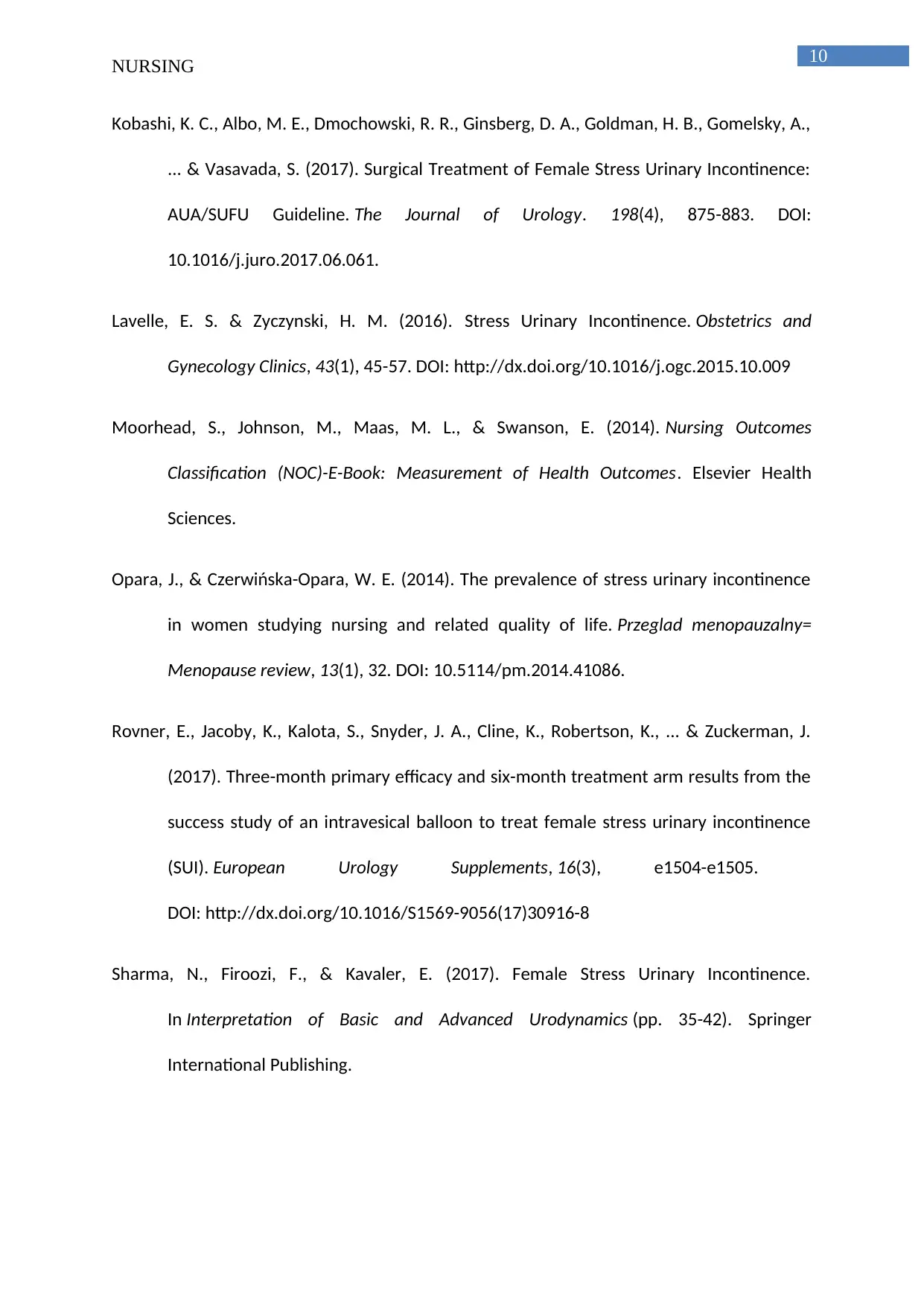
10
NURSING
Kobashi, K. C., Albo, M. E., Dmochowski, R. R., Ginsberg, D. A., Goldman, H. B., Gomelsky, A.,
... & Vasavada, S. (2017). Surgical Treatment of Female Stress Urinary Incontinence:
AUA/SUFU Guideline. The Journal of Urology. 198(4), 875-883. DOI:
10.1016/j.juro.2017.06.061.
Lavelle, E. S. & Zyczynski, H. M. (2016). Stress Urinary Incontinence. Obstetrics and
Gynecology Clinics, 43(1), 45-57. DOI: http://dx.doi.org/10.1016/j.ogc.2015.10.009
Moorhead, S., Johnson, M., Maas, M. L., & Swanson, E. (2014). Nursing Outcomes
Classification (NOC)-E-Book: Measurement of Health Outcomes. Elsevier Health
Sciences.
Opara, J., & Czerwińska-Opara, W. E. (2014). The prevalence of stress urinary incontinence
in women studying nursing and related quality of life. Przeglad menopauzalny=
Menopause review, 13(1), 32. DOI: 10.5114/pm.2014.41086.
Rovner, E., Jacoby, K., Kalota, S., Snyder, J. A., Cline, K., Robertson, K., ... & Zuckerman, J.
(2017). Three-month primary efficacy and six-month treatment arm results from the
success study of an intravesical balloon to treat female stress urinary incontinence
(SUI). European Urology Supplements, 16(3), e1504-e1505.
DOI: http://dx.doi.org/10.1016/S1569-9056(17)30916-8
Sharma, N., Firoozi, F., & Kavaler, E. (2017). Female Stress Urinary Incontinence.
In Interpretation of Basic and Advanced Urodynamics (pp. 35-42). Springer
International Publishing.
NURSING
Kobashi, K. C., Albo, M. E., Dmochowski, R. R., Ginsberg, D. A., Goldman, H. B., Gomelsky, A.,
... & Vasavada, S. (2017). Surgical Treatment of Female Stress Urinary Incontinence:
AUA/SUFU Guideline. The Journal of Urology. 198(4), 875-883. DOI:
10.1016/j.juro.2017.06.061.
Lavelle, E. S. & Zyczynski, H. M. (2016). Stress Urinary Incontinence. Obstetrics and
Gynecology Clinics, 43(1), 45-57. DOI: http://dx.doi.org/10.1016/j.ogc.2015.10.009
Moorhead, S., Johnson, M., Maas, M. L., & Swanson, E. (2014). Nursing Outcomes
Classification (NOC)-E-Book: Measurement of Health Outcomes. Elsevier Health
Sciences.
Opara, J., & Czerwińska-Opara, W. E. (2014). The prevalence of stress urinary incontinence
in women studying nursing and related quality of life. Przeglad menopauzalny=
Menopause review, 13(1), 32. DOI: 10.5114/pm.2014.41086.
Rovner, E., Jacoby, K., Kalota, S., Snyder, J. A., Cline, K., Robertson, K., ... & Zuckerman, J.
(2017). Three-month primary efficacy and six-month treatment arm results from the
success study of an intravesical balloon to treat female stress urinary incontinence
(SUI). European Urology Supplements, 16(3), e1504-e1505.
DOI: http://dx.doi.org/10.1016/S1569-9056(17)30916-8
Sharma, N., Firoozi, F., & Kavaler, E. (2017). Female Stress Urinary Incontinence.
In Interpretation of Basic and Advanced Urodynamics (pp. 35-42). Springer
International Publishing.
Secure Best Marks with AI Grader
Need help grading? Try our AI Grader for instant feedback on your assignments.

11
NURSING
Sinclair, A. J., & Ramsay, I. N. (2011). The psychosocial impact of urinary incontinence in
women. The Obstetrician & Gynaecologist, 13(3), 143-148. DOI:
10.1576/toag.13.3.143.27665.
Swenson, C. W., Kolenic, G. E., Trowbridge, E. R., Berger, M. B., Lewicky-Gaupp, C.,
Margulies, R. U., ... & DeLancey, J. O. (2017). Obesity and stress urinary incontinence
in women: compromised continence mechanism or excess bladder pressure during
cough?. International Urogynecology Journal, 1-9. DOI: 10.1007/s00192-017-3279-6.
Western Health (2017). Western Continence Services, Westernhealth.org.au. Retrieved 20
January 2018, from
http://www.westernhealth.org.au/Services/Western_Continence_Services/Pages/
default.aspx
Wood, L. N. & Anger, J. T. (2014). Urinary incontinence in women. Bmj, 349(15), 4531-
4542.DOI: 10.1136/bmj.g4531.
NURSING
Sinclair, A. J., & Ramsay, I. N. (2011). The psychosocial impact of urinary incontinence in
women. The Obstetrician & Gynaecologist, 13(3), 143-148. DOI:
10.1576/toag.13.3.143.27665.
Swenson, C. W., Kolenic, G. E., Trowbridge, E. R., Berger, M. B., Lewicky-Gaupp, C.,
Margulies, R. U., ... & DeLancey, J. O. (2017). Obesity and stress urinary incontinence
in women: compromised continence mechanism or excess bladder pressure during
cough?. International Urogynecology Journal, 1-9. DOI: 10.1007/s00192-017-3279-6.
Western Health (2017). Western Continence Services, Westernhealth.org.au. Retrieved 20
January 2018, from
http://www.westernhealth.org.au/Services/Western_Continence_Services/Pages/
default.aspx
Wood, L. N. & Anger, J. T. (2014). Urinary incontinence in women. Bmj, 349(15), 4531-
4542.DOI: 10.1136/bmj.g4531.
1 out of 11
Related Documents
Your All-in-One AI-Powered Toolkit for Academic Success.
+13062052269
info@desklib.com
Available 24*7 on WhatsApp / Email
![[object Object]](/_next/static/media/star-bottom.7253800d.svg)
Unlock your academic potential
© 2024 | Zucol Services PVT LTD | All rights reserved.





